
Pilots know that single-engine planes tend to have a left-turning tendency, and every student pilot knows what it’s like to have your CFI insisting on “more right rudder!” P-factor is one of the causes of this left-turning tendency but it can be a somewhat confounding topic for student pilots and more experienced pilots alike.
So what is P-factor?
P-factor, or asymmetric propeller loading, causes a left turning tendency in propeller-driven planes when the aircraft has a high angle of attack. This is caused by the propeller angle on the right side of the aircraft experiencing a larger angle of attack (and therefore more thrust) than the left.
In this article, we will explain what causes P-factor, situations where you will experience the greatest effects of P-factor, and ways to counteract this phenomenon.
P-factor Explained
Background Knowledge on P-Factor
You may remember from private pilot ground school that there are four “left-turning tendencies” experienced by propeller planes.
As a refresher, these left-turning tendencies are:
- Spiraling slipstream
- Torque
- Gyroscopic precession
- P-factor (discussed in this article)
The “p” in P-factor stands for plane, in the geometric sense of the word.
The motion of the rotating propeller blades form a disc that lies in a flat plane. We’ll use the word disc in place of plane to avoid further confusion.
For the sake of this explanation, we will use the example of a two-bladed propeller, but the explanation applies to propellers with any number of blades.
We’ll refer to the blade moving downward through its arc as the “downward” blade, and likewise the other blade will be the “upward” blade.
In a standard configuration where the propeller spins clockwise (from the view of the cockpit) the downward blade is on the right side and the upward blade is on the left side – this is important.
Flying at a Low Angle of Attack
When an aircraft is operating at a shallow low angle of attack (i.e. straight and level flight), both the upward and downward blades of the propeller are meeting the air at the same angle.
Because the upward and downward blade are meeting the air at the same angle of attack and moving at the same speed, they produce the same thrust and no turning tendency is produced.

Flight at a High Angle of Attack
However, if the disc of the propeller blades is meeting the oncoming air at an angle, P-factor comes into play. The most obvious scenario when this happens is during a climb.
When the disc of the propeller blades is tilted toward the vertical, the upward and downward blades are in very different scenarios.
The angle of attack of the upward moving (left side) blade will be smaller than the angle of attack of the downward moving (right side) blade.
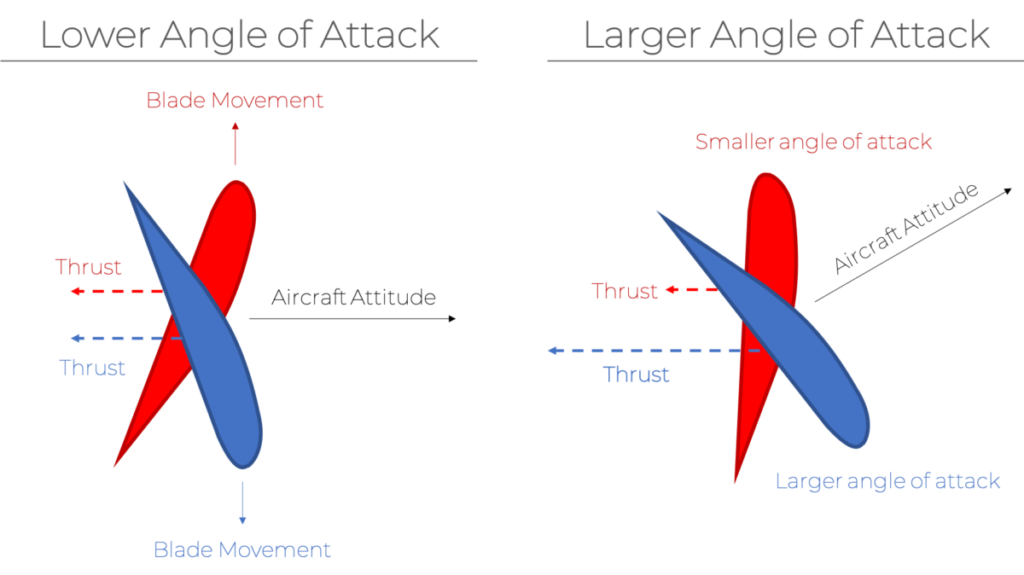

Because the right side propeller blade is taking a bigger “bite” of air, it will produce more thrust than the left side propeller blade. This thrust differential has the effect of yawing the plane to the left.
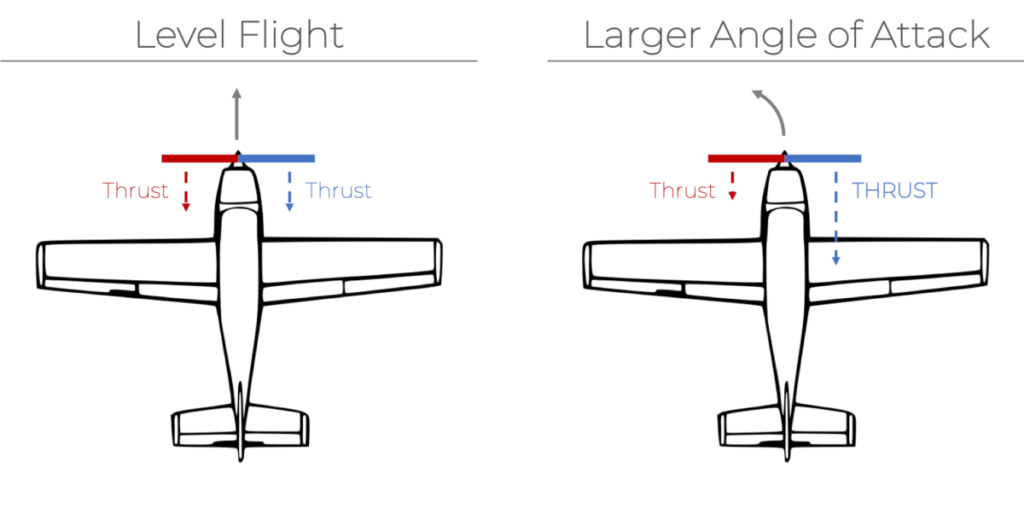
If you learn better with videos, this video does a great job explaining P-factor:
When will P-factor be most pronounced?
P-factor is most noticeable when the plane of the propeller disc is tilted at high angles from the vertical plane.
This can occur in climbs, during the landing flare (and in power-on landings), in slow flight, or in tail-dragger airplanes.
P-factor During a Climb
P-factor is often pronounced during a climb because you are pitching the aircraft up to climb, increasing the angle of attack of the plane. The tilt of the plane will tilt the disc of the propeller and cause asymmetric thrust.
As explained above, the downward propeller blades on the right side will produce more thrust, causing a yaw to the left.
This P-factor will become more pronounced the higher the angle between the path of travel of your plane and the plane of your propeller disc is, and will continue throughout your climb if your angle of attack is high.
Remember that angle of attack depends on several factors (power setting, speed, elevator position, weight, etc.) If your plane has a rudder trim, counteracting P-factor and other left turning tendencies while in a climb is a good reason to use it.
P-factor During the Landing Flare
During landing, you will raise the nose of the airplane to ensure the main gear touches down first and to protect the nose gear and propeller.
As you pull back on the yoke, the thrust between the left and right propeller blades will change as the difference in their angles of attack grows.
P-factor does not usually generate a very large yawing effect during landing as you will be at or near idle engine power during the flare. However, it can be a noticeable effect, especially on planes with a naturally nose-high landing attitude.
You should anticipate needing more right rudder as you pull back the yoke during the landing flare, particularly if you are conducting a power-on landing such as in a short field operation with a very high angle of attack.
P-factor During Slow Flight and Go-Arounds
You don’t need to be climbing to have a nose-high attitude. It is possible to fly at a low airspeed and maintain level flight with a high power setting and high angle of attack – also known as slow flight.
One of the reasons you need more right rudder in slow flight is, you guessed it, P-factor!
To maintain altitude during slow flight, you will need to raise your nose.
By raising the nose of the plane, you will cause the angle of attack of the right side, downward moving propeller blade to increase, causing a leftward yaw.
One time this is especially important to remember is during a go-around.
By increasing your power setting and pitching up to a high angle of attack while at a low speed, you will experience a considerable leftward yaw. P-factor is one reason for this left turning tendency and should be anticipated.
P-Factor in Taildraggers (Conventional Landing Gear)
Taildraggers, or planes with “conventional” landing gear will experience P-factor during the takeoff roll, unlike most tricycle gear airplanes.
This is because the propeller is naturally tilted up due to the low tail wheel.
Remember to make good rudder inputs during your takeoff roll in taildraggers. Luckily, taildraggers usually have large, effective rudders which can counteract strong left turning tendencies, even at low airspeeds.
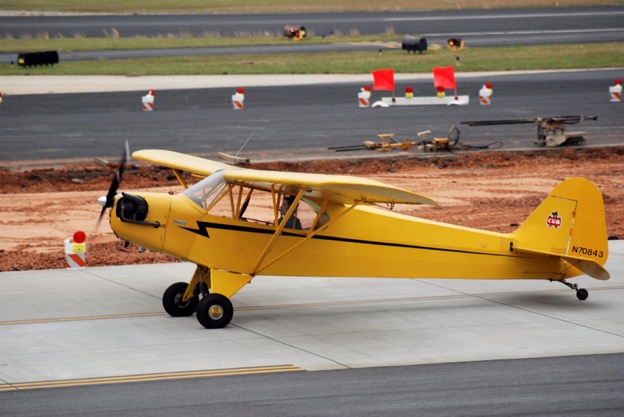
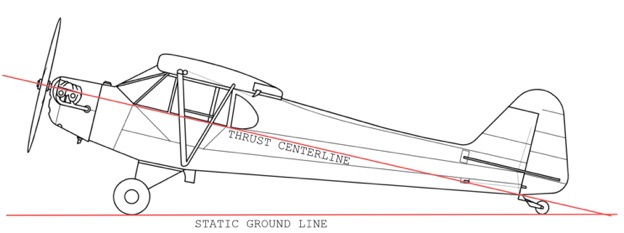
P-Factor in Tricycle Gear Aircraft
It’s worth mentioning that some tricycle gear airplanes (planes with one wheel in front) also have a nose-high attitude while sitting on the ramp or taking off.
This is usually because of a larger nose wheel or a big propeller that needs more ground clearance.
Although the effect isn’t as great as in taildraggers, any plane that has a naturally nose-high attitude during the takeoff roll will experience P-factor.
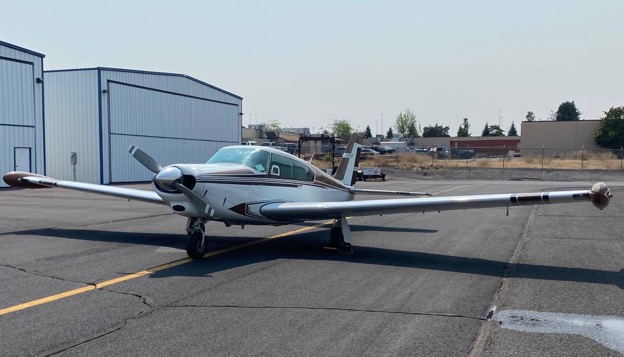

A Piper PA-24 Comanche has a relatively nose-high attitude on the ground despite having tricycle landing gear.
P-factor could be experienced during the takeoff roll, causing a left-turning tendency while still on the ground (among the 3 other left turning tendency factors).
Can p-factor occur in a descent?
“Negative” p-factor can occur during a negative angle of attack and cause a right turning tendency, but typically descents are achieved by reducing power and not by a significantly nose-low attitude. In this case, the other left-turning tendencies outweigh negative p-factor.
That being said, if you were to dive suddenly, the upward traveling blade on the left side of the propeller would take a larger “bite” of air. This would indeed cause a yaw to the right – a negative P-factor.
Yet still, many of us experience the need for left rudder in a descent. But typically this is not due due to a “negative” P-factor.
Instead, this is usually caused by your right rudder trim setting that was appropriate for climb and cruise, but is no longer needed for descent.
This will manifest itself as needing left rudder in the descent, but usually you actually just need to alleviate some of the right rudder trim you had applied earlier in the flight.
It’s a good mental exercise to consider the positive and negative p-factor dynamics of climbs, descents, and even dives (if you are flying aerobatics). Take some time to consider a diving airplane and the two blades’ relation to the oncoming air and how that could cause a negative P-factor.
If you feel comfortable with that, for extra credit, which rudder pedal would you need to use to counteract P-factor if you were climbing while inverted?
Counteracting P-Factor
The most important step in counteracting the effects of P-factor is to anticipate when it will be greatest.
When adding power or increasing angle of attack, you should expect to need more right rudder. This is due to a number of reasons, including P-factor.
Most pilots anticipate needing right rudder during the takeoff roll and climb out, and will be used to how much rudder input is needed in their specific plane.
Sometimes though, the need for right rudder can come as a surprise, such as during a go-around.
An easy way to remember this is to imagine a rod connecting your right foot to the throttle. When you advance the throttle, you should also advance the right rudder pedal.
Go-arounds can be a potentially dangerous maneuver with high P-factor and should be practiced regularly.
The combination of low airspeed, a high angle of attack, high power setting and strong yawing tendency of a plane conducting a go-around mean you’ll be at a higher risk for a spin/stall accident.
Read our article on uncoordinated flight for more information.
P-factor in Twin-Engine Aircraft
Twin-Engine Aircraft With Counter-Rotating Propellers
Any aircraft with a propeller is subject to P-factor.
Some twin-engine airplanes like light Piper twins have counter-rotating blades. This means that one engine (usually the right engine) will spin counter-clockwise and the other engine (usually the left engine) will spin clockwise.
This has the effect of cancelling out P-factor.
The left engine will produce a leftward yaw from P-factor, while the right hand engine will produce a rightward yaw. However, in the event of an engine failure P-factor would come back into play.
Twin-Engine Aircraft Without Counter-Rotating Propellers
In reality, the majority of twin-engine aircraft do not have counter-rotating propellers.
In most twins, both engines spin clockwise – usually because it is simpler to construct both engines the same way.
In these twin aircraft, P-factor and other left turning tendencies are even more critical to understand. This is because of the concept of a critical engine.
The critical engine in a twin-engine plane is the engine that you don’t want to fail – usually the left engine. If the critical engine fails, P-factor will be even more pronounced.
This is especially true considering your angle of attack will increase when operating with only one engine if you want to maintain level flight or a climb.
If your “critical” left engine fails, the lone right engine will cause yaw to the left. This compounds with effects of P-factor – that rightmost propeller blade has a longer moment arm to act on the airframe.
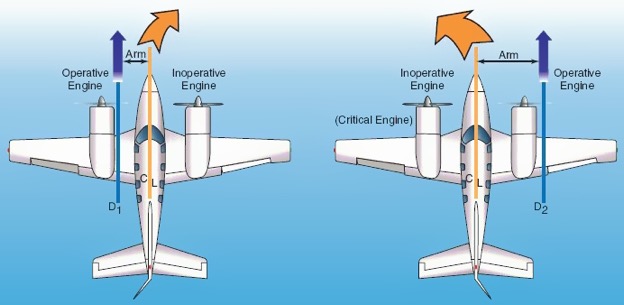
This all means if you suffer a failure on the “critical” left engine, you may need a truly massive right rudder input – possibly more right rudder than your plane has to give, depending on speed and other factors.
If the non-critical right engine fails, the extra thrust of the downward blade of the left engine has a smaller moment arm to act through, causing less P-factor yaw than if the critical engine had failed.
More importantly, flying with only the left engine will cause a yaw to the right anyways.
The overall rightward yaw of the lone left engine will actually help to cancel out the left turning P-factor tendency of the engine. That’s why a non-critical engine failure is always easier to recover from and requires much less rudder correction.
When your non-critical right engine fails, you will need to use only a moderate amount of left rudder.
P-Factor Summary
P-factor is possibly the most confounding of the 4 left-turning tendencies we discuss in general aviation. It’s worth taking the time to understand the aerodynamic forces at work and learning how they can affect your flights.
At the end of the day, a propeller blade is just a rotating airfoil. Instead of producing lift, this rotating airfoil produces thrust – understanding this fact was critical to the Wright Brothers’ success.
Just like varying the angle of attack of your wing produces lift, varying the angle of attack of your propeller blades will produce different amounts of thrust. Because there are multiple propeller blades, different amounts of thrust are produced when their angles of attack are different from one another.



